Sunday Dubai Metro Timings Explained: Your Guide
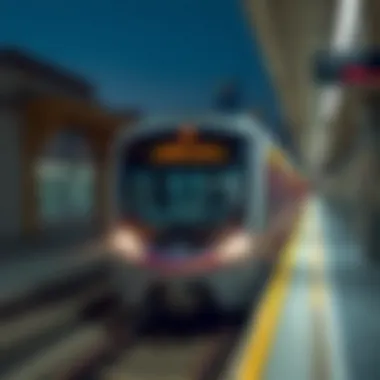
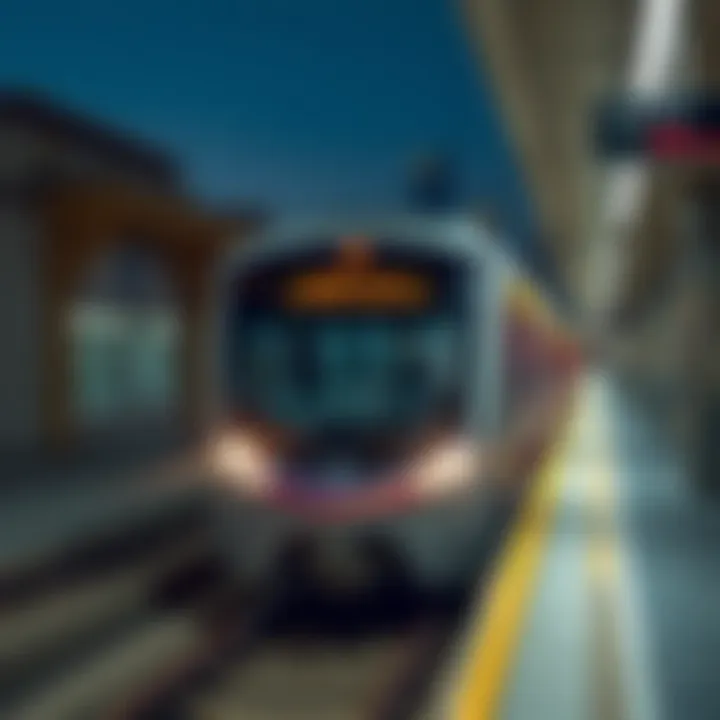
Intro
Navigating Dubai can sometimes feel like an Olympic challenge, especially when you're trying to figure out the Sunday Metro timings. In a city that thrives on efficiency, knowing when you can hop onto the metro is not just handy; it's essential. With the hustle and bustle of both residents and tourists in the mix, understanding the operational timings of the Dubai Metro can significantly impact your travel experience. This guide opens the door to a deeper insight into how the metro functions on Sundays, discussing everything from peak hours to the additional services available around metro stations.
The challenge, of course, is figuring out how this all works. Factors like peak versus off-peak hours, special events, and seasonal changes can muddy the waters. Furthermore, as we dive deeper, we can explore how the metro schedule fits into the broader public transport landscape of Dubai, revealing the convenience of this transportation option. Understanding these nuances will help you make the most of your time, whether you're a seasoned local or a first-time visitor.
The convenience of the metro is matched by the various complementary services you can find at stations. Seamlessly connecting with buses and taxis, these services can enhance your journey, allowing for easy transitions from one mode of transport to another.
So saddle up as we explore the ins and outs of the Dubai Metro on Sundays, ensuring you are fully equipped to tackle the city with ease. This is your go-to guide for mastering the metro system, helping you navigate Dubai with confidence and efficiency.
Overview of Dubai Metro
The Dubai Metro stands as a pivotal component in the city’s infrastructure, intertwining convenience and modernity with the pulse of urban life. Understanding the functionality of the Metro, especially on Sundays, highlights not only operational timings but also the broader implications for urban mobility in this vibrant city. The necessity of this system cannot be overstated; it caters to daily commuters and curious visitors alike, making navigating the sprawling metropolis much more manageable.
History and Development
The roots of the Dubai Metro can be traced back to the early 2000s, reflecting the city’s ambitious vision for a sustainable transportation solution. Ground broke in 2006, leading to a transformative era for public transit in the United Arab Emirates. Initially launched in 2009, the Metro was a crucial stepping stone towards reducing traffic congestion that had surged alongside rapid urban expansion. This ambitious initiative sought to blend aesthetics with efficiency, as evidenced by its sleek design and user-friendly operation. Over the years, additional lines and stations have been added, extending its reach and enhancing its role in daily life.
System Structure and Components
The structure of the Metro is cleverly designed to facilitate an uninterrupted flow of communications across key areas in Dubai. The Red Line and the Green Line are the primary corridors, serving as arteries of travel in the city. With a combination of elevated and underground stations, the system is not just functional but also visual stunning, offering commuters scenic views of some of the city’s landmarks, including the Burj Khalifa and the Dubai Marina. Each station is equipped with essential amenities, making the transit experience as smooth as possible.
"The efficiency of the Dubai Metro serves as a benchmark for modern urban transit systems globally, combining cutting-edge technology with passenger convenience."
Significance in Urban Mobility
Integrating the Metro into Dubai's public transport network significantly reduces reliance on personal vehicles, thus mitigating the potential for gridlock that often plagues metropolitan areas. This reliance on a sophisticated public transportation network fosters increased accessibility, thereby linking residential neighborhoods to business districts, tourist attractions, and educational institutions. Furthermore, it positions Dubai as a forward-thinking city that values sustainability.
Moreover, the convenience offered through the extensive route options enables residents and tourists to traverse the city with ease. Metro travel not only promises time savings but also contributes positively to the environment by minimizing the carbon footprint associated with commuting. The Dubai Metro is not merely a mode of transport; it represents a commitment to innovation and progress, ensuring that the city remains a contender in the global metropolitan arena.
Sunday Metro Operations
Understanding the operations of the Dubai Metro on Sundays is key to navigating the city's extensive transport network with ease. For both residents and visitors, mastering the schedules and frequency can make a notable difference in easing daily commutes or travel plans. Sundays, being the beginning of the workweek for many, see a distinctive flow of passenger traffic as people return to their routines. The importance of knowing how the metro operates on this day extends beyond just catching a train; it shapes how one can effectively plan their day and seamlessly integrate metro travel with other activities.
Standard Operating Hours on Sundays
On Sundays, the Dubai Metro operates from 8:00 AM to midnight, which is slightly different from the weekdays when services start earlier. This schedule accommodates those who need to travel for work and those looking to enjoy the city after a weekend. Knowing this timing is crucial for passengers as it establishes the start and end of their travel plans. It’s worth noting that different lines, like the Red and Green lines, might offer varied frequencies, especially during peak hours.
Moreover, passengers should be aware that the last train leaves from both terminal stations right at midnight, so timing is of utmost importance. If you’re planning to catch those final minutes of nightlife, marking your watch may just save you a long wait for an alternate mode of transport.
Frequency of Trains
The frequency of trains on Sundays varies throughout the day. During peak hours from 8:00 AM to 10:00 AM and then from 5:00 PM to 8:00 PM, the trains run every 5 minutes. This is beneficial for commuters rushing to work or heading back home after a long day.
On the other hand, during off-peak hours, the wait time between trains can stretch to every 10 minutes. Therefore, understanding this rhythm can help streamline your journey—show up early if you want a comfy seat rather than standing after a long day.
Tip: To make the most of your travel experience, consider downloading the RTA Dubai app, which provides real-time updates on train schedules and platform information.
Additional Considerations
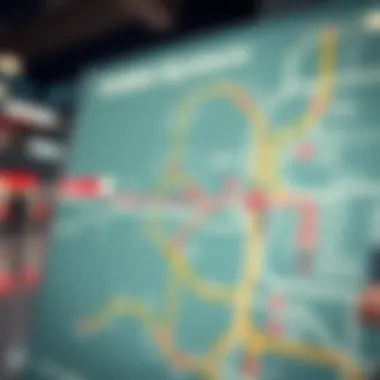
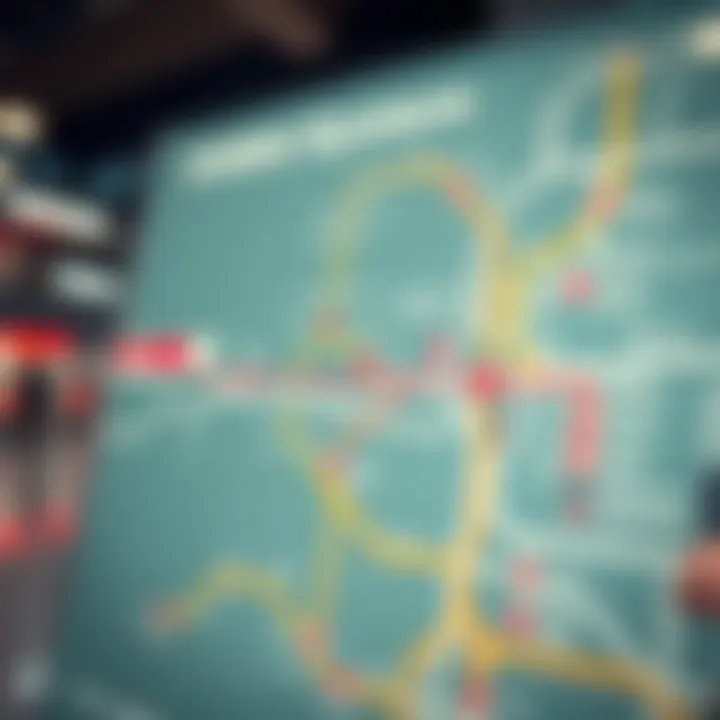
While Sunday metro operations may appear straightforward, factors like maintenance schedules and special events must also be factored in. Regular maintenance can lead to temporary changes in operations, so keeping an eye on updates from the official RTA website ( www.rta.ae) can provide peace of mind.
Navigating the Sunday metro system in Dubai is not just about catching a ride; it’s about planning strategically according to the operating hours and train frequency. For those with an eye on efficiency, this knowledge is invaluable.
Factors Affecting Sunday Timings
Understanding the factors that influence Sunday timings of the Dubai Metro is crucial for anyone navigating the bustling urban landscape. Factors like seasonal changes and unique calendar events often shape the metro's operational hours. By recognizing these variables, commuters can effectively plan their journeys, avoid peak crowds, and ultimately enhance their travel experiences.
Impact of Seasonal Changes
Changes in seasons significantly affect the public transport landscape, including the Dubai Metro operations on Sundays. For instance, during the cooler months, such as December to February, more people tend to utilize the metro. The pleasant weather encourages outdoor activities and events, leading to an uptick in passenger volume. Consequently, the metro may run with increased frequency to accommodate the higher demand.
On the flip side, scorching summer months, particularly from June to September, might see a decrease in ridership. Many residents tend to stay indoors, opting for climate-controlled environments rather than venturing out. During this time, the metro may adjust its operating hours, possibly reducing frequency to save on operational costs and maintain efficiency. Understanding these seasonal patterns can be a game-changer for commuters wanting to optimize their travel time.
Special Events and Holiday Schedules
Special events and holidays can impact the Dubai Metro significantly, often leading to altered schedules and increased service frequencies. For instance, during major holidays like Eid Al Fitr and Eid Al Adha, a spike in the number of commuters is common. Many individuals travel to visit family or participate in festive activities, leading the metro authority to extend operating hours or increase train frequency to cater to high passenger volumes.
Events like the annual Dubai Shopping Festival also influence timings. During such occasions, the metro might see extended hours to accommodate late-night shoppers and increased foot traffic. It’s advisable for commuters to stay informed about any potential changes in the schedule in anticipation of these events. Furthermore, monitoring local announcements can provide crucial details about shifts in timings or additional services provided during these busy times.
These factors are not just static but tend to evolve, reflecting trends and changing commuter needs, making it essential for regular users to keep abreast of the operational nuances.
"Understanding your travel environment is key, especially in a dynamic city like Dubai, where conditions can change with the seasons and events."
Navigating Metro Stations on Sundays
Navigating the Metro stations on Sundays is a critical aspect for those utilizing Dubai's public transport system. This not only enhances the commuting experience but also provides essential insights into optimizing travel efficiency. On Sundays, the city witnesses a mix of both tourists and locals, making an understanding of the stations' operations particularly pertinent.
Being acquainted with various factors like facilities available at the stations and their accessibility features can lead to a smoother journey. Knowing what to expect allows commuters to plan their trips effectively, minimizing waiting times and enhancing comfort during travel.
Facilities Available at Stations
The facilities available at Dubai Metro stations are designed to cater to the diverse needs of commuters. One of the standout features is the cleanliness and upkeep of the stations. With attention to hygiene, all metro stations are regularly maintained to ensure a pleasant environment.
Integral facilities include:
- Ticket vending machines: These machines are equipped with multi-lingual options making it easier for tourists.
- Restrooms: Clean and accessible restrooms are available at each station, offering convenience.
- Waiting areas: Comfortable seating areas allow passengers to relax while waiting for trains.
- Information desks: Staffed with knowledgeable personnel, information desks can assist travelers with inquiries about routes and timings.
- Free Wi-Fi: Many stations provide complimentary Wi-Fi, allowing commuters to stay connected while waiting.
"The Dubai Metro is more than just a mode of transport; it's a key component in enhancing urban mobility and convenience for both residents and visitors."
Accessibility Features
Dubai is known for its efforts in making public transport accessible to everyone. The accessibility features in Metro stations emphasize this commitment.
Key elements include:
- Wheelchair ramps: Every station is equipped with ramps, ensuring easy entry and exit for persons with disabilities.
- Elevators: Strategically located elevators provide easy access to different levels of the station.
- Tactile guidance paths: For the visually impaired, tactile paths guide passengers from the entrance to platforms, enhancing safety and independence.
- Designated seating: Trains have allocated seating for those in need, including elderly and differently-abled passengers.
By emphasizing these facilities and accessibility features, commuters can effortlessly navigate the Dubai Metro system on Sundays. This not only appeals to the everyday commuter but also reflects the inclusive nature of public transportation in the UAE. Understanding these offerings leads to an enhanced travel experience, making it easier to explore the vibrant city of Dubai.
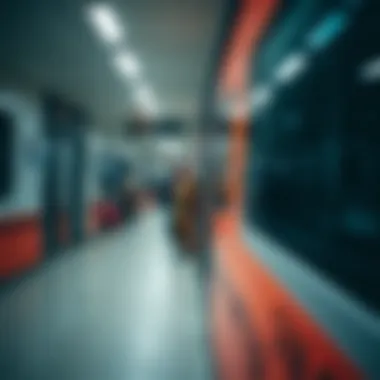
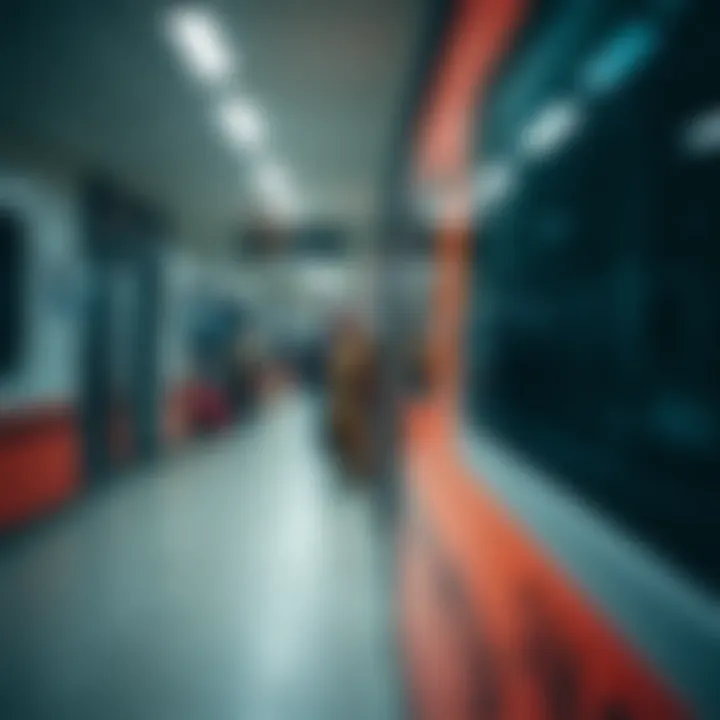
Integrating Other Transport Modes
The Dubai Metro serves as a backbone for urban mobility, but it doesn’t operate in a vacuum. The integration of other transport modes is crucial for enhancing the overall commuting experience. This smooth transfer between different forms of transportation not only amplifies convenience but also optimizes travel times for commuters. When navigating the city on a Sunday, understanding these connections can make all the difference.
Buses and Taxis Connections
Buses and taxis have been long-standing allies of the Dubai Metro, rounding off the public transport ecosystem. The bus network in Dubai, operated by the Roads and Transport Authority (RTA), complements the metro lines effectively, unleashing access to areas that the metro might not cover directly.
- Convenient Transfers: Many metro stations serve as hubs for various bus routes, allowing passengers to hop on a bus without much hassle. For instance, al-Rahmaniya Station connects directly to several key bus lines, easing the transition for commuters.
- Accessibility: This synergy enables those traveling from outskirts or less populated districts to reach the metro with minimal inconvenience, painlessly linking them to the wider city. Moreover, taxi stands located adjacent to metro stations provide quick and flexible options for users needing to reach further destinations or travel late at night when buses may not be operational.
- Timeliness: Trains and buses often run on synchronized schedules, allowing for seamless transfers without long waiting times. This connection is particularly advantageous on Sundays, when many people head out for leisure or work.
Ride-Sharing Services
The advent of ride-sharing services like Uber and Careem has transformed how people navigate cities globally, and Dubai is no exception. These services play a significant role in enhancing the efficiency of Sunday travels in particular, as they offer additional flexibility that traditional transport methods cannot always match.
- On-Demand Convenience: Ride-sharing platforms allow passengers to summon a vehicle at their convenience, making it especially attractive when public transport schedules don’t align with their plans. For example, a visitor leaving the Dubai Mall can request a ride right after finishing their weekend shopping rather than waiting for a bus.
- Last-Mile Connectivity: Often, these services fill the gap from metro stations to final destinations. This model is particularly beneficial for those who might be carrying shopping bags or are in a hurry; it simplifies the last leg of their journey significantly.
- User-Friendly Apps: The apps come with features that let users estimate prices and wait times in advance, providing a level of predictability that many commuters find appealing. This translates into time-saving and allows residents and visitors alike to plan their Sunday musings without much fuss.
Integrating other modes of transportation with the Dubai Metro doesn’t just enhance individual journeys; it represents a pivotal evolution in urban planning and mobility strategies in Dubai. With the right knowledge, commuters can navigate the city’s transport landscape more efficiently, ensuring their Sunday outings are both smooth and enjoyable.
User Tips for Sunday Travel
Understanding how to navigate the Dubai Metro system efficiently on Sundays can greatly enhance your commuting experience. With a diverse array of users, from busy professionals to curious tourists, Sunday travel presents unique opportunities and challenges that one must be prepared for. This section delves into practical tips aimed at optimizing your journey, ensuring that you can enjoy the convenience and efficacy of this urban transport network without the usual hiccups.
Optimal Times to Travel
Timing is everything when it comes to using the Dubai Metro on Sundays. Observing the flow of passengers can make a world of difference. The peak operational hours generally draw heavier crowds, particularly from 8 AM to 10 AM as commuters head to work or appointments. Understanding these specifics allows you to plan accordingly. If you can, consider the following timings for a smoother ride:
- Early Morning: 6 AM to 7:30 AM. The metro is relatively less crowded.
- Midday: 11 AM to 1 PM. This is usually an off-peak period, allowing for an easier journey.
- Late Afternoon: After 5 PM can be busy, as people return home. Aim for after 7 PM for more breathing room.
By cleverly timing your travel, you not only circumvent the rush but also appreciate the customer service at stations, which can be a bit rushed during peak times.
Planning Routes Ahead
Being proactive with your route planning is essential. Much like preparing for a road trip, plotting out your journey to ensure seamless transfers and minimal delays is key. Here are several strategies to effectivelly plan your trip:
- Familiarize Yourself with the Metro Map: Before stepping out, take a moment to study the metro routes. Understanding which stations are closest to your destinations can save you time.
- Check the Schedule: Sundays may have slightly different operating hours, so it’s vital to confirm the metro times beforehand. Websites such as Dubai Metro's official page offer real-time updates.
- Utilize Apps and Online Tools: Tools like Google Maps or local transport apps can help you track train schedules, optimal routes, and any potential delays.
- Leave Early: Even if you see no major delays, giving yourself a buffer is wise. It minimizes stress and allows you to enjoy your surroundings.
By putting in a little effort to map out your travel plans, you not only save time but also enhance your overall metro experience. Being prepared can transform your simple metro ride into a more enjoyable feature of your Sunday exploration in Dubai.
Commuter Experience on Sundays
The commuter experience on Sundays in Dubai Metro is significant for both residents and visitors of the city. Understanding how this particular day affects commuting patterns can help maximize convenience and efficiency for all who rely on this vital transportation network.
Volume of Passengers
On Sundays, the volume of passengers tends to fluctuate based on several elements. For instance, many expatriates and students might return to the city after the weekend. Given that businesses, schools, and universities reverberate to life after a day off, the Metro sees a noticeable spike in users during early morning hours, particularly between 7 AM and 9 AM. This rush corresponds with the start of the workweek for most industries.
- Morning Rush Hour: Expect crowded trains particularly when schools resume and adults embark on their commute. This is when the Metro not only handles trips from residential areas but also sees inflow from nearby stations with workers heading towards their offices.
- Afternoon Slump: As the day saunters on, particularly after lunch, passenger volume tends to diminsh. This leads to more breathing space in the carriages, providing an opportunity for a more relaxed journey.
- Evening Patterns: The late afternoon also brings another wave of commuters, usually shuffling back home after work. The volumes can be intense around popular hubs such as Burj Khalifa or Dubai Mall, as tourists gather.
Understanding these peaks and valleys in passenger volume can help you find a more comfortable travel window. It’s always wise to plan ahead, especially if you want to avoid the crush of the crowd.
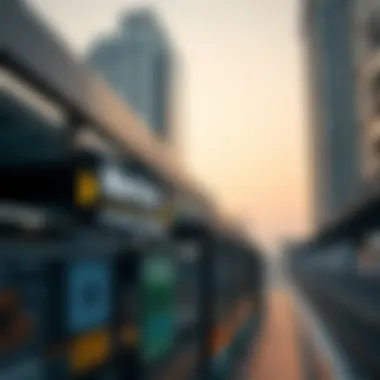

Typical Commuter Profiles
Diverse backgrounds enrich the commuter experience on Sundays, reflecting Dubai’s multicultural tapestry. Typically, commuters can fit into several profiles:
- Business Professionals: Dressed in sharp suits, they navigate their way to offices or meetings, often glued to their phones, catching up on emails.
- Expatriate Families: Families stroll into the stations, often with children in tow, ready for a weekend outing to parks or shopping spaces. For them, Sunday can mean running errands or enjoying the day out together.
- Tourists: This group often buzzes around, fascinated by the sights, capturing memories through photographs. Visitors rely on Metro to explore major attractions, promoting seamless transitions from one landmark to another.
- Students: Many individuals enrolled in universities make their way to lectures or study groups. They often travel together, creating a lively, energetic atmosphere that brings a sense of community.
Each commuter brings their unique rhythm and behavior to the Metro. Knowing who you might share your ride with adds to the understanding of the overall experience, suggesting that patience and awareness can work wonders in managing the bustling travel environment.
The commuter experience on Sundays captures the essence of urban mobility, emphasizing the need for adaptability and awareness for smooth transitions throughout Dubai’s vital transportation system.
As this insightful city continues to evolve, so too does the Metro’s role in accommodating a growing and diverse population. This underscores the necessity for future enhancements and services to align with commuter needs.
Future Developments and Projections
Understanding the future trajectory of the Dubai Metro is critical for anyone invested in the urban landscape of this rapidly evolving city. With the demand for efficient public transportation riding high, projections and developments planned for the Metro system promise not just to enhance commuter experience but also to facilitate sustainable urban growth. The Dubai Metro is often viewed as the backbone of public transport in the emirate, and its planned enhancements and changes are set to cater to a growing population that expects modern convenience alongside speed.
Planned Extensions and Upgrades
The Dubai Metro network is eyeing significant extensions that could reshape the way people navigate the city. Planned projects will see new lines added to the existing routes, making it easier for commuters to access various districts without the hassle of road traffic.
For instance, the Route 2020 initiative is particularly notable. This extension, which aims to connect the Red Line to the Expo 2020 site, highlights one of the government’s key objectives: improving accessibility to major attractions and economic hubs. Further extensions may include plans for connections to airports and residential districts, reducing transit times and providing greater integration with other forms of transportation.
Benefits of these upgrades include:
- Increased Capacity: Additional lines will accommodate more passengers, easing congestion during peak hours.
- Improved Connectivity: Direct access to business centers could encourage more commuters to choose public transport, resulting in lower traffic congestion.
- Sustainability: With an increase in ridership comes a reduction in reliance on fossil fuels for private automobiles, contributing to the emirate's overall sustainability goals.
Anticipated Changes in Operations
As the developments in the system progress, operational changes are also anticipated to keep pace with technological advancements and commuter needs. One such change includes the implementation of smart ticketing options that provide a seamless travel experience. Through mobile applications, passengers may soon be able to purchase tickets, plan routes, and receive real-time travel updates all in one place. This can save time and reduce the frustrations associated with ticket queues at the stations.
Another significant anticipated adjustment is the potential alteration of train frequency based on demand analytics. By analyzing passenger flow data, the operators could optimize the schedule to prevent overcrowding during busy times, ensuring that trains run more frequently when they are needed most.
Moreover, operational hours might also see extensions, especially during special events or festivals, to cater to increased demand. Such flexibility underscores the Dubai Metro's dedication to improving commuter experience while adapting to the demands of a vibrant city.
"By investing in the Metro’s future, Dubai is not just enhancing its public transport but also shaping a modern metropolis where convenience meets innovation."
In sum, both the planned extensions and anticipated operational changes of the Dubai Metro are crucial elements that stakeholders—from investors to everyday commuters—should closely monitor. These enhancements will illuminate the path towards a more connected and accessible Dubai, benefitting a diverse audience while reflecting the city’s ambitions to be a world-class destination.
The End
In summing up the discussions throughout this comprehensive guide, the Sunday operations of the Dubai Metro stand as a pivotal component in the city’s public transport landscape. Highlighting the specific timings and the factors affecting these schedules is not simply an academic exercise; it bears significant implications for everyone in this dynamic environment including investors, realtors, renters, developers, and homeowners.
One cannot overlook how understanding Sunday timings can enhance the overall commuter experience. For example, commuters can plan their travels during off-peak hours to avoid overcrowding on trains, thus allowing for a smoother journey. This planning extends beyond mere convenience; it can lead to more productive use of time and lessen travel-related frustrations.
Additionally, a close examination of the interplay between metro timings and complementary transport services reveals how integrated public transport can genuinely transform urban mobility, encouraging more residents and visitors to take advantage of a more environmentally friendly alternative to cars. Being aware of bus links, ride-sharing services, and even pedestrian pathways around the metro can offer users seamless transitions, further optimizing their journeys.
In this article, we underscored the significance of factors that are often overlooked, such as seasonal shifts and special events, which can drastically alter metro schedules. Comprehending these nuances allows users to anticipate changes and adjust their plans accordingly, reflecting a savvy approach to navigating the city.
Ultimately, the insights gained from understanding the Sunday Dubai Metro timings are invaluable. They aren’t merely numbers on a schedule; they are essential pieces of information that empower individuals to make informed travel decisions in a bustling hub like Dubai. Staying informed opens the way to increase accessibility, reducing travel times, and creating an enhanced urban commuting culture that benefits everyone in the long run.
"The best way to predict the future is to create it."
Including an awareness of metro timings is a step toward taking control of one’s travel plans, resulting in a more confident and efficient way to explore the vibrant landscape this city has to offer.
For further details, consider checking resources such as Metrolink, or engaging with community discussions on platforms like Reddit.
Understanding these considerations thus not only informs better travel plans but also affects broader decisions tied to living and working in such a vibrant metropolis.











